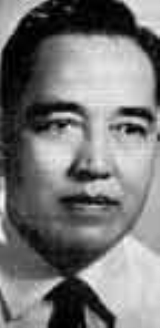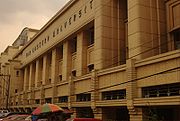
Pablo Antonio
Encyclopedia
Pablo S. Antonio was a Filipino
architect
. A pioneer of modern Philippine architecture
, he was recognized in some quarters as the foremost Filipino modernist architect of his time. He was conferred the rank and title of National Artist of the Philippines
by President
Ferdinand Marcos
in 1976.
in 1901. He was orphan
ed by the age of 12, and had to work in the daytime in order to finish his high school education at night. He studied architecture at the University of Santo Tomas
but dropped out of school in order to assist in the design and construction of the Legislative Building
(now, the National Museum of the Philippines
).
Ramon Arevalo, the engineer in charge of the Legislative Building project, funded Antonio's education at the University of London
. He completed a five-year architecture course in three years, graduating in 1927.
 Antonio first came into prominence in 1933 with the construction of the Ideal Theater along Avenida Rizal in Manila
Antonio first came into prominence in 1933 with the construction of the Ideal Theater along Avenida Rizal in Manila
. His work caught the eye of the founder of the Far Eastern University
in Manila, Nicanor Reyes, Sr., who was looking to build a school campus that was modern in style. Between 1938 to 1950, he designed several buildings on the university campus in the Art Deco
style. The FEU campus is considered as the largest ensemble of surviving Art Deco architecture in Manila, and in 2005, it received an Honorable Mention citation from the UNESCO
for the body's 2005 Asia-Pacific Heritage Awards for Culture Heritage Conservation.
Antonio also designed the White Cross Sanitarium (1938) along Santolan Road in San Juan City, and the Manila Polo Club (1950) in Makati City
. He likewise designed the Ramon Roces Publications Building (now Guzman Institute of Electronics) in Soler Street in Manila, the Capitan Luis Gonzaga Building, and the Boulevard-Alhambra (now called Bel-Air) Apartments Building in Roxas Boulevard & where Manila Bay Hostel is located on the 4th floor, this Bel-Air Apartments is near T. M. Kalaw Avenue & beside Miramar Hotel. Bel-Air Apartments building was designed by Pablo Santonio and built in 1937.
Apart from the Ideal Theater, Antonio also designed several other theaters in Manila, including the Life Theater, the Scala Theater, the Lyric Theater, and the Galaxy Theater. As of 2008, only the Galaxy Theater remains standing, though it is threatened with demolition.
Antonio was also conscious of adapting his buildings to the tropical climate of the Philippines. In order to highlight natural light and also avoid rain seepage, he utilized sunscreens, slanted windows and other devices.
Antonio himself has been quoted as stating that "buildings should be planned with austerity in mind and its stability forever as the aim of true architecture, that buildings must be progressive, simple in design but dignified, true to a purpose without resorting to an applied set of aesthetics and should eternally recreate truth" .
When he was named National Artist of the Philippines
in 1976, he was only the second architect so honored, after his contemporary, Juan Nakpil
.
Philippines
The Philippines , officially known as the Republic of the Philippines , is a country in Southeast Asia in the western Pacific Ocean. To its north across the Luzon Strait lies Taiwan. West across the South China Sea sits Vietnam...
architect
Architect
An architect is a person trained in the planning, design and oversight of the construction of buildings. To practice architecture means to offer or render services in connection with the design and construction of a building, or group of buildings and the space within the site surrounding the...
. A pioneer of modern Philippine architecture
Architecture of the Philippines
The architecture of the Philippines is a reflection of the history and heritage of the country. The most prominent historic constructions in the archipelago are from the Spanish, Japanese, Malay, Hindu, Chinese, and American cultures....
, he was recognized in some quarters as the foremost Filipino modernist architect of his time. He was conferred the rank and title of National Artist of the Philippines
National Artist of the Philippines
A National Artist of the Philippines is a title given to a Filipino who has been given the highest recognition for having made significant contributions to the development of Philippine arts...
by President
President of the Philippines
The President of the Philippines is the head of state and head of government of the Philippines. The president leads the executive branch of the Philippine government and is the commander-in-chief of the Armed Forces of the Philippines...
Ferdinand Marcos
Ferdinand Marcos
Ferdinand Emmanuel Edralin Marcos, Sr. was a Filipino leader and an authoritarian President of the Philippines from 1965 to 1986. He was a lawyer, member of the Philippine House of Representatives and a member of the Philippine Senate...
in 1976.
Early life
Antonio was born in Binondo, ManilaBinondo, Manila
Binondo is an enclave in Manila primarily populated by ethnic Chinese living in the Philippines. Chinatown, Manila is the oldest Chinatown in the world, established in 1594. Historically, this was where the Spanish permitted converted sangleys, their indigenous Filipino wives, and their mixed-race...
in 1901. He was orphan
Orphan
An orphan is a child permanently bereaved of or abandoned by his or her parents. In common usage, only a child who has lost both parents is called an orphan...
ed by the age of 12, and had to work in the daytime in order to finish his high school education at night. He studied architecture at the University of Santo Tomas
University of Santo Tomas
The Pontifical and Royal University of Santo Tomas, The Catholic University of the Philippines , is a private Roman Catholic university run by the Order of Preachers in Manila. Founded on April 28, 1611 by archbishop of Manila Miguel de Benavides, it has the oldest extant university charter in the...
but dropped out of school in order to assist in the design and construction of the Legislative Building
Congress of the Philippines
The Congress of the Philippines is the national legislature of the Republic of the Philippines. It is a bicameral body consisting of the Senate , and the House of Representatives although commonly in the Philippines the term congress refers to the latter.The Senate is composed of 24 senators half...
(now, the National Museum of the Philippines
National Museum of the Philippines
The Museum of the Filipino People is a department of the National Museum of the Philippines that houses the Anthropology and Archaeology Divisions of the National Museum. It is located in the Agrifina Circle, Rizal Park, Manila adjacent to the main National Museum building...
).
Ramon Arevalo, the engineer in charge of the Legislative Building project, funded Antonio's education at the University of London
University of London
-20th century:Shortly after 6 Burlington Gardens was vacated, the University went through a period of rapid expansion. Bedford College, Royal Holloway and the London School of Economics all joined in 1900, Regent's Park College, which had affiliated in 1841 became an official divinity school of the...
. He completed a five-year architecture course in three years, graduating in 1927.
Works

Manila
Manila is the capital of the Philippines. It is one of the sixteen cities forming Metro Manila.Manila is located on the eastern shores of Manila Bay and is bordered by Navotas and Caloocan to the north, Quezon City to the northeast, San Juan and Mandaluyong to the east, Makati on the southeast,...
. His work caught the eye of the founder of the Far Eastern University
Far Eastern University
Far Eastern University in the University Belt area, West Sampaloc, City of Manila, is a nonsectarian, private university in the Philippines. Created by the merger of Far Eastern College and the Institute of Accounts, Business and Finance, FEU became a university in 1934 under the guidance of...
in Manila, Nicanor Reyes, Sr., who was looking to build a school campus that was modern in style. Between 1938 to 1950, he designed several buildings on the university campus in the Art Deco
Art Deco
Art deco , or deco, is an eclectic artistic and design style that began in Paris in the 1920s and flourished internationally throughout the 1930s, into the World War II era. The style influenced all areas of design, including architecture and interior design, industrial design, fashion and...
style. The FEU campus is considered as the largest ensemble of surviving Art Deco architecture in Manila, and in 2005, it received an Honorable Mention citation from the UNESCO
UNESCO
The United Nations Educational, Scientific and Cultural Organization is a specialized agency of the United Nations...
for the body's 2005 Asia-Pacific Heritage Awards for Culture Heritage Conservation.
Antonio also designed the White Cross Sanitarium (1938) along Santolan Road in San Juan City, and the Manila Polo Club (1950) in Makati City
Makati City
The City of Makati is one of the 17 cities that make up Metro Manila, one of the most populous metropolitan areas in the world. Makati is the financial center of the Philippines and one of the major financial, commercial and economic hubs in Asia...
. He likewise designed the Ramon Roces Publications Building (now Guzman Institute of Electronics) in Soler Street in Manila, the Capitan Luis Gonzaga Building, and the Boulevard-Alhambra (now called Bel-Air) Apartments Building in Roxas Boulevard & where Manila Bay Hostel is located on the 4th floor, this Bel-Air Apartments is near T. M. Kalaw Avenue & beside Miramar Hotel. Bel-Air Apartments building was designed by Pablo Santonio and built in 1937.
Apart from the Ideal Theater, Antonio also designed several other theaters in Manila, including the Life Theater, the Scala Theater, the Lyric Theater, and the Galaxy Theater. As of 2008, only the Galaxy Theater remains standing, though it is threatened with demolition.
Death
Antonio died in Manila, Philippines on June 14, 1975 due to health reasons. The cause of his death is still not mentioned until after he died.Appreciation
Antonio's architecture and its adoption of Art Deco techniques was radical for its day, neoclassicism being the dominant motif of Philippine architecture when he began his career. His style noted for its simplicity and clean structural design. He was cited taking taking Philippine architecture into a new direction, with "clean lines, plain surfaces, and bold rectangular masses." Antonio strived to make each building unique, avoiding obvious trademarks.Antonio was also conscious of adapting his buildings to the tropical climate of the Philippines. In order to highlight natural light and also avoid rain seepage, he utilized sunscreens, slanted windows and other devices.
Antonio himself has been quoted as stating that "buildings should be planned with austerity in mind and its stability forever as the aim of true architecture, that buildings must be progressive, simple in design but dignified, true to a purpose without resorting to an applied set of aesthetics and should eternally recreate truth" .
When he was named National Artist of the Philippines
National Artist of the Philippines
A National Artist of the Philippines is a title given to a Filipino who has been given the highest recognition for having made significant contributions to the development of Philippine arts...
in 1976, he was only the second architect so honored, after his contemporary, Juan Nakpil
Juan Nakpil
Juan F. Nakpil was a Filipino architect, teacher and a community leader. In 1973, he was named one of the National Artists for architecture, and tapped as the Dean of Filipino Architects....
.

